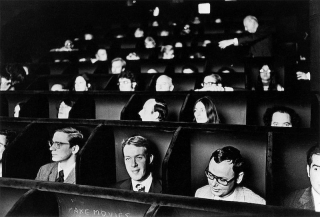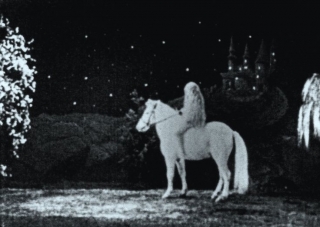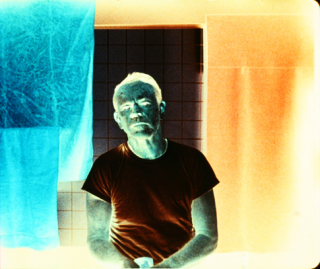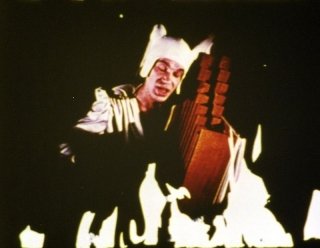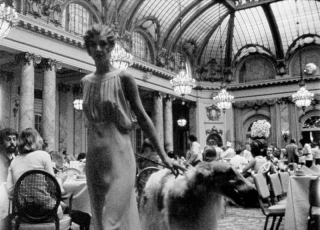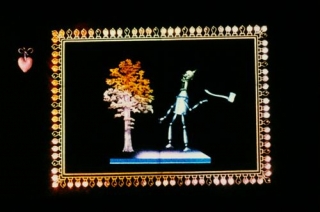Date: 9 January 2013 | Season: Anthology Film Archives, Jonas Mekas
ANTHOLOGY FILM ARCHIVES AND ESSENTIAL CINEMA
9—28 January 2013
London BFI Southbank NFT2
Anthology Film Archives was established in 1969 as the first museum devoted to film as an art form. The organisation had its roots in other initiatives also founded by Jonas Mekas, including the Film-Makers’ Cooperative and Showcase, and the New American Cinema Group, whose rousing manifesto began: ‘The official cinema all over the world is running out of breath. It is morally corrupt, aesthetically obsolete, thematically superficial, temperamentally boring.’
At the heart of Anthology’s mission was the creation of a repertory that would define the art of cinema. The uncompromising ‘Essential Cinema’ collection was chosen by a committee that included Stan Brakhage, James Broughton, Ken Kelman, Peter Kubelka, Jonas Mekas and P. Adams Sitney. It incorporates features by Chaplin, Eisenstein and Renoir alongside avant-garde classics by Deren, Frampton and Warhol.
Like any canon, it had its detractors, but the frequent criticism that it only contained works made up to the early 1970s could not be helped – following the death of primary sponsor Jerome Hill, Anthology was unable to maintain its acquisition programme. Despite this, the Essential Cinema remains an extraordinary gathering of the some of the greatest works of cinema history, and nowadays only represents a small portion of the Archive’s rare and unique holdings.
At Anthology’s first home, in a wing of the New York Public Theatre, an extraordinary projection space was built to exhibit the film collection. Designed by Peter Kubelka and known as the ‘Invisible Cinema’, its unique seating arrangement restricted the audience’s vision to the screen, which was in turn the only source of illumination in the room. In 1974, Anthology relocated to a Fluxus Cooperative building designed by George Maciunas, but its long-term base since the 1980s has been the Second Avenue Courthouse where it maintains daily programmes in two cinemas, a gallery, and its unparalleled reference library.
To complement the Jonas Mekas season, these four screenings present works by his contemporaries with a special emphasis on titles in the Essential Cinema collection. The selection also foregrounds the important restoration projects by Anthology and other archives, which preserve films for future generations and enable us to view the very best available prints.
Date: 9 January 2013 | Season: Anthology Film Archives, Jonas Mekas
ANTHOLOGY FILM ARCHIVES AND ESSENTIAL CINEMA PROGRAMME 1
Wednesday 9 January 2013, at 6:10pm
London BFI Southbank NFT2
Maya Deren was at the forefront of a movement that revolutionised cinema by using portable 16mm equipment to reinvent film as an artistic medium that could be the vision of an individual working alone. The filmmakers associated with the New American Cinema invented radical new approaches to photography, soundtracks and editing to create works that remain vital a half-century later.
Maya Deren, Meshes of the Afternoon, 1943, 14 min
Peter Kubelka, Schwechater, 1958, 1 min
Bruce Conner, Cosmic Ray, 1961, 4 min
Marie Menken, Hurry! Hurry!, 1957, 3 min
Gregory Markopoulos, Ming Green, 1966, 7 min
Stan Brakhage, Reflections on Black, 1965, 12 min
Joseph Cornell (with Larry Jordan), The Midnight Party, c.1938/1969, 4 min
Ken Jacobs, Blonde Cobra, 1963, 33 min
Bruce Baillie, Castro Street, 1966, 10 min
Date: 15 January 2013 | Season: Anthology Film Archives, Jonas Mekas
ANTHOLOGY FILM ARCHIVES AND ESSENTIAL CINEMA PROGRAMME 2
Tuesday 15 January 2013, at 6:20pm
London BFI Southbank NFT2
Jerome Hill was the artist and philanthropist whose support made Anthology a reality. Heir to a railroad fortune, he was also an accomplished filmmaker, winning an Oscar for his documentary Albert Schweizer. Film Portrait is a remarkable autobiography that incorporates home movies, staged scenes, animation and experimental techniques. Screening with a short introduction to Anthology made for French television by Pip Chodorov.
Pip Chodorov, Anthology Film Archives, 2002, 7 min
Jerome Hill, Film Portrait, 1972, 81 min
Date: 22 January 2013 | Season: Anthology Film Archives, Jonas Mekas
ANTHOLOGY FILM ARCHIVES AND ESSENTIAL CINEMA PROGRAMME 3
Tuesday 22 January 2013, at 6:20pm
London BFI Southbank NFT2
Rather than using film as a way to tell stories, artists frequently explore the fundamental qualities of the medium and its potential for structuring events in time. Paul Sharits and Tony Conrad exploit the flicker effect in their psychedelic films. 69 is a kinetic display of single-frame animation, whilst Contrathemis recalls the absolute cinema of 1920s. Owen Land uses humour to undermine the rigor of later structural filmmakers.
Dwinell Grant, Composition 2: Contrathemis, 1941, 5 min
Robert Breer, 69, 1968, 4 min
Beverly & Tony Conrad, Straight and Narrow, 1970, 10 min
Paul Sharits, Apparent Motion, 1975, 30 min
Owen Land (formerly known as George Landow), Wide Angle Saxon, 1975, 22 min
Date: 23 January 2013 | Season: Anthology Film Archives
ESSENTIAL EXPERIMENTS: WARREN SONBERT
Wednesday 23 January 2013, at 8:40pm
London BFI Southbank NFT2
To coincide with BFI’s Jonas Mekas and Anthology Film Archives seasons, these two works by Warren Sonbert demonstrate an entirely different approach to lyrical cinema. Having emerged in New York’s bohemian scene, with connections to the Warhol Factory and the coterie of filmmakers around Gregory Markopoulos, Sonbert travelled extensively to film Carriage Trade, his epic montage of people and places. In the more exuberant Friendly Witness, lush imagery is animated by sixties pop and opera.
Warren Sonbert, Carriage Trade, 1972, 61 min
Warren Sonbert, Friendly Witness, 1989, 22 min
Programmed and introduced by independent curator Mark Webber.
Date: 28 January 2013 | Season: Anthology Film Archives, Jonas Mekas
ANTHOLOGY FILM ARCHIVES AND ESSENTIAL CINEMA PROGRAMME 4
Monday 28 January 2013, at 8:30pm
London BFI Southbank NFT2
Surrealism and the poetic sensibility were amongst the defining traits of the post-war avant-garde. In 1947, the teenage Kenneth Anger drew inspiration from Jean Cocteau to make Fireworks, a bold, astounding, homoerotic vision. Pull My Daisy was narrated by Jack Kerouac and includes Allen Ginsberg, Alice Neel and Delphine Seyrig among its illustrious cast. The programme concludes with fragments from Harry Smith’s abandoned Wizard of Oz project.
Willard Maas, Geography of the Body, 1943, 7 min
Douglas Crockwell, Glen Falls Sequence, 1937-46, 8 min
Kenneth Anger, Fireworks, 1947, 20 min
Ed Emshwiller, Thanatopsis, 1962, 5 min
Robert Frank & Alfred Leslie, Pull My Daisy, 1959, 28 min
Harry Smith, Oz: The Tin Woodman’s Dream, 1967, 15 min
